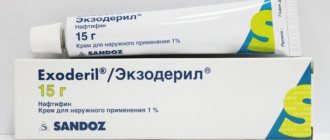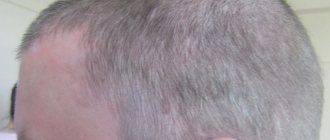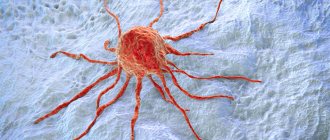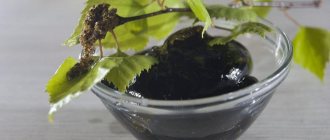Author
: Grachev Ilya Illarionovich
Editor
: Efremov Mikhail Mikhailovich
Date of publication: 08/14/2018 Date of update: 02/16/2020
The very first manifestations of psoriasis often appear on the head, then spreading throughout the body. Psoriasis on the scalp occurs with itching and the risk of bacterial complications. If you suspect the psoriatic nature of the rash, you should immediately consult a doctor - the disease is highly treatable at the very beginning. The article contains all the information about the symptoms and all known methods of treating this form of the disease.
Causes of psoriasis on the head
This is a chronic non-contagious dermatological process that develops in individuals with a hereditary predisposition. The causes of psoriasis on the scalp and the mechanism of its development are not fully understood. But it has been established that the process develops against the background of metabolic and immune disorders. The body loses control over the division of skin epithelial cells: they begin to divide much faster. Signs of keratinization also quickly appear, manifested in the form of peeling. At the same time, inflammatory processes develop in the skin.
The main cause of scalp psoriasis is a hereditary predisposition. Scientists are trying to identify the genes responsible for transmitting the disease from generation to generation. Individual altered areas related to different genes that are found in patients and their close relatives have already been identified.
But a person who has a genetic predisposition does not necessarily get sick. External and internal predisposing factors are no less important. Psoriasis of the scalp begins in genetically predisposed individuals due to exposure to the following factors:
- mechanical irritation of the skin (with a hair brush with hard teeth; injury to small wounds and crusts that appear with seborrhea, etc.);
- cold exposure;
- past infectious diseases; often after streptococcal impetigo - purulent rashes mainly on the skin of the face; develops in children and becomes the impetus for the development of an autoimmune process;
- chronic stress and high loads;
- frequent smoking, alcohol abuse;
- diet violations - irregular, unhealthy dry food, excessive consumption of high-calorie foods and spicy seasonings;
- for hormonal disorders that affect the condition of the sebaceous glands of the skin - obesity, imbalance of sex hormones, diabetes, diseases of the thyroid gland, pituitary gland, hypothalamus;
- for diseases of the liver and kidneys with impaired function of these organs; neutralization of toxins occurs in the liver, and through the kidneys they are eliminated from the body; intoxication can become a trigger point in the development of the disease.
Under the influence of one or several factors, the interaction of the organism with the environment is disrupted. Protein, fat and carbohydrate metabolism is disrupted, which causes acceleration of metabolic processes in the skin and its peeling.
Psoriasis of any localization can spread throughout the body, so do not delay treatment.
See how easily the disease can be cured in 10-12 sessions.
Changes in the immune system manifest themselves in the form of increased sensitivity of the skin to any external influences (including combing or frequent hair coloring). In response to such influences, antibodies are produced to one’s own cells, provoking the occurrence of an autoimmune inflammatory process. The reasons why inflammation begins are not yet fully understood. This is one of the priority tasks of medicine in the treatment of psoriasis.
Sources
- Ninosu N., Roehrich F., Diehl K., Peitsch WK., Schaarschmidt ML. Psoriasis care during the time of COVID-19: real-world data on changes in treatments and appointments from a German university hospital. // Eur J Dermatol - 2022 - Vol - NNULL - p.; PMID:33871361
- Thatiparthi A., Martin A., Liu J., Egeberg A., Wu JJ. Biologic Treatment Algorithms for Moderate-to-Severe Psoriasis with Comorbid Conditions and Special Populations: A Review. // Am J Clin Dermatol - 2022 - Vol - NNULL - p.; PMID:33861409
- RahimZahedi M., Torabizadeh C., Najafi Kalyani M., Moayedi SA. The Relationship between Spiritual Well-Being and Resilience in Patients with Psoriasis. // Dermatol Res Pract - 2022 - Vol2021 - NNULL - p.8852730; PMID:33854545
- Haftek M., Roy DC., Liao IC. ARTICLE: Evolution of Skin Barrier Science for Healthy and Compromised Skin. // J Drugs Dermatol - 2021 - Vol20 - N4 - p.s3-s9; PMID:33852254
- Svedbom A., Mallbris L., Larsson P., Nikamo P., Wolk K., Kjellman P., Sonkoly E., Eidsmo L., Lindqvist U., Ståhle M. Long-term Outcomes and Prognosis in New-Onset Psoriasis . // JAMA Dermatol - 2022 - Vol - NNULL - p.; PMID:33851956
- Adly M., Woo TE., Traboulsi D., Klassen D., Hardin J. Understanding Dermatologic Concerns Among Persons Experiencing Homelessness: A Scoping Review and Discussion for Improved Delivery of Care. // J Cutan Med Surg - 2022 - Vol - NNULL - p.12034754211004558; PMID:33818163
- Griffiths CEM., Armstrong AW., Gudjonsson JE., Barker JNWN. Psoriasis. // Lancet - 2022 - Vol397 - N10281 - p.1301-1315; PMID:33812489
- El-Komy MHM., Abdelnaby A., El-Kalioby M. How does COVID-19 impact psoriasis practice, prescription patterns, and healthcare delivery for psoriasis patients? A cross-sectional survey study. // J Cosmet Dermatol - 2022 - Vol - NNULL - p.; PMID:33811728
- Hung YT., Le PH., Kuo CJ., Tang YC., Chiou MJ., Chiu CT., Kuo CF., Huang YH. The Temporal Relationships and Associations between Cutaneous Manifestations and Inflammatory Bowel Disease: A Nationwide Population-Based Cohort Study. // J Clin Med - 2022 - Vol10 - N6 - p.; PMID:33810197
- Löfvendahl S., Norlin JM., Schmitt-Egenolf M. Prevalence and incidence of palmoplantar pustulosis in Sweden: a population-based register study. // Br J Dermatol - 2022 - Vol - NNULL - p.; PMID:33792911
Symptoms of psoriasis of the scalp
Psoriasis on the scalp manifests itself in the form of characteristic symptoms. The disease can begin acutely with multiple rashes (vulgar form of psoriasis) or gradually with itching and flaking of the skin, and only then characteristic rashes appear (seborrheic form). Psoriasis on the head, photo:
The more common onset is gradual, in the form of dandruff and flaking. In the early stages, these are small areas in the occipital region. Peeling spreads to larger areas and itching begins. Constant scratching of the skin contributes to its roughening and abrasions. What does psoriasis on the scalp look like? The initial symptoms of psoriasis on the head in the photo look like this:
In the area of scratches and abrasions, redness first appears, and then small inflammatory nodules and papules, surrounded by a bright rim that rises above the surface of the skin. Accompanied by severe itching, the rashes increase in size and merge with each other. Features of the rashes are:
- white “shavings” covering the papules; when scraped, it resembles a stearic speck; in the seborrheic form, the scales have a yellowish color and the phenomenon of the stearin spot is not so pronounced;
- if you scrape off all the “chips”, a smooth translucent surface is revealed;
- further scraping leads to the appearance of droplets of blood on the surface - “blood dew”.
In the photo, three signs look like this:
These three characteristic manifestations distinguish scalp psoriasis from seborrheic dermatitis, with which it is easily confused. Subsequently, the papules merge and form psoriatic plaques, which have different configurations and sometimes spread over the entire surface of the head.
The course of scalp psoriasis can be mild with the appearance of isolated rashes at the initial stage. These rashes then go through all three stages of development. In severe forms, the rashes occupy an entire significant area and spread to the face and neck in the form of a crown - an inflammatory rim covered with silvery scales. The hair roots are not affected, but the psoriatic process is often accompanied by a bacterial, fungal or mixed infection, which leads to complications that are not so easy to cure. This is what the crown looks like, photo:
Antistress
Psycho-emotional disorders and tension negatively affect the course of the disease and very often provoke its occurrence. Of primary importance in prevention is the normalization and stability of the emotional state and nervous system. You should try to eliminate external irritants as much as possible. Ancient practices like yoga and meditation, as well as extra sleep, can help with this. In more severe situations, they use sedatives or use herbal teas. If psoriasis involves disorders of the nervous system - headaches, sleep disturbances, nervousness, then the use of medications is possible. Effective - motherwort, valerian, Nervo-Vit. They allow you to normalize your sleep patterns, increase your immune system, and improve your resistance to stress. It’s difficult to achieve results without making your own efforts; you need to take everything more calmly.
Stages of psoriasis on the head
The disease lasts a long time, exacerbations are replaced by remissions. The frequency of exacerbations and the severity of symptoms depend on the presence of provoking factors.
Progressive stage
Rash and inflammation spread, accompanied by severe itching. In the initial stage, Koebner's symptom is present - the appearance of psoriatic rashes at the site of scratches and abrasions.
Stationary
The process is in the same state, not spreading, but not dying out.
Regressive
The process gradually subsides, the itching disappears, the rash turns pale, the inflammatory infiltrate decreases, gradually taking on the appearance of a spot; the color of the rash fades starting from the center, forming ring-shaped figures with a brighter border. Sometimes they begin to turn pale from the periphery to the center and then take on the appearance of whitish rings (a symptom of psoriasis on the head - Voronov's pseudoatrophy). The healing phase can take quite a long time and gradually only white depigmented spots remain on the skin.
Use of vitamin complexes
Vitamins have an extremely beneficial effect not only on the course of the disease, but also on its prevention. Thanks to a strong immune system, it is possible to prevent relapse; at the same time, metabolism improves, which has a beneficial effect on the condition of the skin. Important vitamins are: 1. A – it is responsible for keratinization, which significantly accelerates skin regeneration; 2. E – mainly valued for its antioxidant effects. It also prevents deviations in metabolism and acts as an integral part of DNA synthesis; 3. D – is a regulating substance for the exchange of phosphorus and calcium. At the same time, it stimulates regeneration in the epidermis and normalizes the membrane and cellular structure; 4. Group B – actively participate in skin metabolism, improve the process of oxygen absorption. The skin elements respond favorably to the presence of B vitamins, which is reflected by the normalization of the nervous system. Most often, foods high in vitamins or medications are used. Recommended are Undevit, Hexavit, and Decamevit, but they should be used based on the doctor’s recommendations.
Treatment methods for psoriasis on the scalp
Good to know
- Treatment of psoriasis on the elbows
- Treatment of psoriasis on the legs
- Treatment of psoriasis on nails
- Treatment of psoriasis on the hands
- Treatment of psoriasis on the face
- Treatment of palmoplantar psoriasis
Scalp psoriasis requires systematic treatment under the supervision of a physician. An active lifestyle, quitting smoking and alcohol, and following a diet are of decisive importance. The disease must be treated comprehensively, using methods taking into account the characteristics of the patient’s body. Complex therapy can include modern European techniques, drug treatment, as well as time-tested oriental methods. Such treatment can immediately significantly improve the patient’s condition and lead to the development of stable remission within a few weeks.
PRP therapy is a method based on the ability of platelets (red blood platelets) to secrete a growth factor that stimulates the regenerative abilities of cells. By centrifugation, the patient's blood is enriched with platelets and then precisely injected into the scalp. The technique allows you to significantly accelerate the onset of remission and prevent the development of relapses.
Autohemotherapy - treatment is carried out by intramuscular injection of a small amount of blood taken from the patient’s vein. This has a general stimulating effect and restores the epithelium of the head. After treatment, stable remission is observed.
Reflexology is the effect of various methods on special points on the body that are reflexively associated with organs and tissues. One of the most ancient and effective traditional methods of treatment. The points can be affected by acupuncture (acupuncture), moxibustion, massage, etc. Treatment of scalp psoriasis with these methods has been practiced in Eastern medicine for thousands of years. Therapeutic procedures are performed by a reflexologist.
Vacuum therapy - exposure to rarefied air on biologically active points - is one of the methods of reflexology. It can be carried out using cans or special equipment. Promotes rapid restoration of damaged tissues. As a result of the use of vacuum therapy, the affected areas are significantly reduced.
Herbal medicine - dermatologists widely use medicinal plants in their practice in the form of infusions, decoctions and ready-made pharmaceutical forms. When used correctly as part of complex treatment, they are very effective both in the initial stages of the disease and in its long-term forms. If you add herbal medicine, the effectiveness of other treatment methods increases and the risk of developing undesirable drug effects decreases.
Red spots on the skin after stress
Diagnosis of skin diseases
Quitting alcohol and smoking
There is no reliable data on whether alcohol can provoke the disease. However, it is known for sure that in patients with already developed psoriasis, the course of the disease is greatly aggravated by drinking alcohol. It is also possible to generalize the usual, vulgar form of the disease into a more severe one, for example, psoriatic erythroderma. Regarding smoking, everything is somewhat simpler. It has been noted that it can provoke both the disease itself and aggravate the current form of the disease. People who consume 20 or more cigarettes per day are especially at risk. The main problem is a decrease in the activity of the immune system due to oxygen deficiency and weakening of muscle tone and vascular walls. It is also important that smoking worsens blood circulation through the capillaries, as well as suppression of antioxidant protection.
Treatment of psoriasis on the head at the Paramita clinic
At the Paramita clinic in Moscow, this disease is treated by dermatologists who have training and clinical experience in treating this disease with all currently known methods. In their work, they use new Western methods of drug treatment in combination with traditional Eastern techniques, which were successfully used by doctors of Ancient China and Tibet for thousands of years.
To avoid relapses, it is necessary to eliminate the cause of the disease.
Read more about our unique method of treating psoriasis
“Paramita” is a leader in the treatment of psoriatic processes in Moscow in a variety of ways with an individual approach to each patient. Several sets of traditional methods in combination with drug treatment can permanently relieve the patient of problems with the scalp.
The effectiveness of treatment at the clinic is noted in their comments and reviews not only by patients who regularly receive maintenance treatment, but also by colleagues from other Moscow clinics.
Sign up for a free initial appointment
Healthy lifestyle
A healthy lifestyle is one of the fundamental factors that influence the well-being of the skin. It is important to have a good daily routine, including getting enough sleep. Doctors advise getting out into nature more often, getting fresh air, going to the sea, resorts, and sanatoriums. Physical activity allows you to restore a healthy state of the body, which is the main factor in preventing disease. Sports activities are excellent, especially fitness and swimming. This set of measures allows you to strengthen the immune system, as well as eliminate nervous tension.
Prevention of psoriasis on the head
Prevention of psoriasis on the scalp is especially necessary for people with a hereditary predisposition who have sick relatives. It includes eliminating the impact of the following factors:
- any prolonged exposure to the skin;
- poor nutrition and sedentary lifestyle;
- prolonged stress and heavy loads;
- smoking and alcohol abuse;
- hormonal disorders - if you suspect such disorders, you should immediately contact an endocrinologist;
- intoxications - promptly treat all chronic diseases that contribute to metabolic and immune disorders.
A dermatologist after an examination can tell you how to cure psoriasis on the scalp. Therefore, you should not delay consulting a specialist, because the initial stages of the disease are much easier to treat. Can this process be cured? It is impossible to cure the disease completely, but if a person is treated regularly, there is a great chance of getting rid of relapses for a long time.
The use of healing massage
Prevention of psoriasis becomes even more effective if you use massage. Massage techniques that stimulate blood circulation are considered especially useful. Thanks to active blood circulation, the removal of metabolites and toxins is accelerated, and the process of skin regeneration is accelerated, which prevents exacerbation of the disease. The massage involves using your fingers to gradually stretch the areas of skin located around the plaques. You need to cover an area of 2-4 cm around the affected area. You shouldn’t touch the plaques themselves, as this can worsen the disease. To prevent the appearance of new plaques, you can massage the whole body. Mostly you need to treat the back, then move on to massaging the limbs and finally the abdomen. The chest responds well to squeezing and rubbing. The duration of the procedure is 10-15 minutes.
Diet for scalp psoriasis?
There is no special diet, but treatment of psoriasis of the scalp involves proper 4 meals a day containing all the ingredients necessary for the body. Products that irritate the skin should not be present on the table:
- spicy, salty, sour;
- fruits rich in essential oils (fresh garlic and onions, radishes);
- fried, smoked, canned foods;
- caffeine-containing drinks – strong tea, coffee, Coca-Cola, etc.;
- alcoholic drinks – they contribute to the development of relapses of the disease.
It has been established that meat foods provoke an exacerbation, so the diet should contain more foods containing complex carbohydrates, lean meat, cottage cheese, yogurt, etc.
Climatotherapy, ultraviolet rays
Ultraviolet irradiation has a beneficial effect on the course of psoriasis and its prevention. Patients are prescribed sunbathing for 5-10 minutes; combustion is unacceptable. Sea water also has a positive effect, especially from the Dead Sea, although this indicator is individual, but on the contrary, it is harmful for some. Skin wounds are a contraindication to swimming in sea water. During an exacerbation, you should not swim. The time for climatotherapy should be adjusted individually. When sunbathing, you need to use protective creams. Your doctor will be able to tell you whether sunbathing will have a beneficial effect, otherwise there is a high risk of exacerbation of the disease.
Drug therapy for scalp psoriasis?
Medicines are selected according to the patient’s condition and the presence of certain symptoms of the disease. In the initial stage of psoriasis on the scalp, the following external remedies are used:
- when weeping, solutions and creams are prescribed that eliminate these symptoms and prevent bacterial and fungal infections; Picladol, Psorilom, Zinocap creams are suitable; Belosalik is prescribed from solutions; apply the medicine to the affected skin areas every day;
- if the skin is dry, then it is treated with ointments; ointment with salicylic acid - has a softening effect; ointments with tar have the same effect; Ointments with zinc and Daivonex ointment (an analogue of vitamin D3 + glucocorticoid betamethasone - help quickly eliminate the symptoms of psoriasis);
- ointments and creams with corticosteroid hormones are prescribed for the treatment of common forms of psoriasis on the scalp;
- Shampoos are widely used; Thus, tar shampoos (Psorilom, Friederm Tar, etc.) relieve inflammation and soften crusts; shampoo with zinc has an antiseptic and softening effect, relieves inflammation; shampoos are used for a long time.
Prescribed drugs
All medications for psoriasis are divided into two groups: hormonal and non-hormonal. The first includes corticosteroids. Their advantage is that the desired effect is achieved quickly. Thanks to the powerful action of corticosteroids, the inflammatory process subsides, peeling and itching are eliminated. However, there is a possibility of a rapid return of symptoms, especially if external therapy is abruptly discontinued. And you can’t use hormonal drugs for a long time.
Therefore, treatment necessarily includes non-hormonal ointments, creams, lotions and gels for psoriasis as further maintenance therapy. These can be products based on zinc, an analogue of vitamin D3, naphthalan and others.
Table 1. Factors influencing the choice of drugs for the treatment of psoriasis
| Objective factors | Subjective factors |
| Form of psoriasis | |
| Disease stage | |
| Prevalence of lesion | Features of the psyche |
| Patient motivation | |
| Past treatment experience |
Table 2. “Hormonal ointments” for psoriasis by strength of activity[1]
| Class (Activity) | INN | Trade name, Manufacturer | INN | Trade name |
| one-component | multi-component | |||
| 4th grade (very strong) | Clobetasol propionate 0.05% | Dermovate, GSK (ointment, cream) | — | |
| Etrivex, Galderma (shampoo) | ||||
| Klovate, Elfa (ointment, cream) | ||||
| Powercourt, Glenmark (cream) | ||||
| Grade 3 (pronounced) | Betamethasone valerate 0.1% | Akriderm, Akrikhin (cream, ointment) | betamethasone+gentamicin | Akriderm Genta, Akrikhin |
| Betameazone dipropionate 0.025%,0.05% | Beloderm, Belupo (ointment, cream, express spray), | Celestoderm-B, MSD | ||
| Celestoderm-B, Bayer (ointment, cream) | betamethasone+gentamicin+clotrimazole | Akriderm GK, Akrikhin | ||
| Triderm, Bayer | ||||
| betamethasone+gentamicin+salicylic acid | Akriderm SK, Akrikhin | |||
| Triderm, Bayer | ||||
| betamethasone + salicylic acid | Belosalik, Belupo | |||
| Diprosalik, Bayer | ||||
| Rederm, Vertex | ||||
| Hydrocortisone butyrate | Laticort, Elfa (ointment, cream, lotion) | — | ||
| Lokoid, Astellas (ointment, cream, lotion) | ||||
| Mometasone | Elokom, Schering Plow (ointment, cream, lotion) | mometasone + salicylic acid | Elocom-S, Schering Plow | |
| Silcaren, Vertex (cream) | ||||
| Triamcinolone | Triakort, Akrikhin (ointment) | — | ||
| Fluorocort, Gedeon Richter (ointment) | ||||
| Fluocinolone acetonide | Sinaflan, Nizhpharm, (liniment), | fluocionol acetonide + neomycin | Flucinar N, Elfa | |
| Sinoderm (ointment, cream, gel), | ||||
| Flucinar, Elfa (ointment, gel) | ||||
| Fluticasone | Cutivate, GSK (ointment, cream) | — | ||
| 2nd grade (secondary) | Alclomethasone | Afloderm, Belupo (ointment, cream) | Hydrocortisone acetate + oxytetracycline | Oxycort, Polfa |
| 1st class (weak) | Hydrocortisone acetate | Hydrocortisone, Elfa, etc. (ointment) | Hydrocortisone acetate + fusidic acid | Fucidin G, Leo |
| Prednisolone | Prednisolone (ointment), Altaivitamins | Hydrocortisone+natamycin+neomycin | Pimafucort, Astellas |
Cloth
Such a factor as high-quality and suitable clothing is one of the principles of preventing psoriasis or its relapse. It is recommended to use soft fabric clothing made from natural materials, preferably in a light color. This will avoid injury to the plaques and reduce pain on the skin. A light color will help make silver scales less noticeable. Linen, cotton and other soft fabrics are optimal for bed linen. You should avoid wearing woolen sweaters and similar irritating materials.









